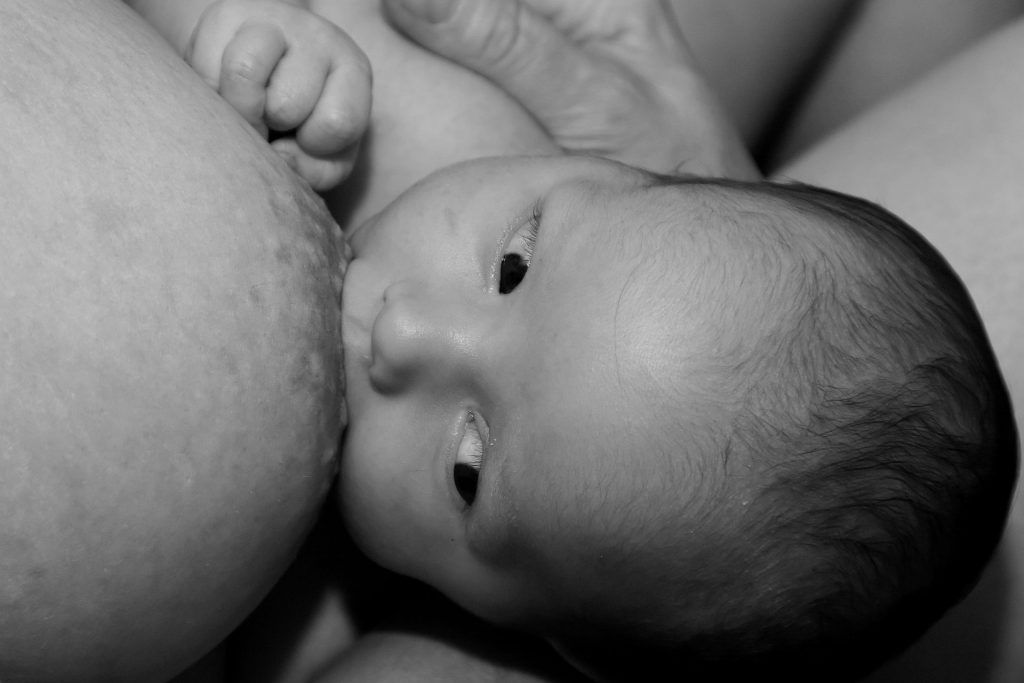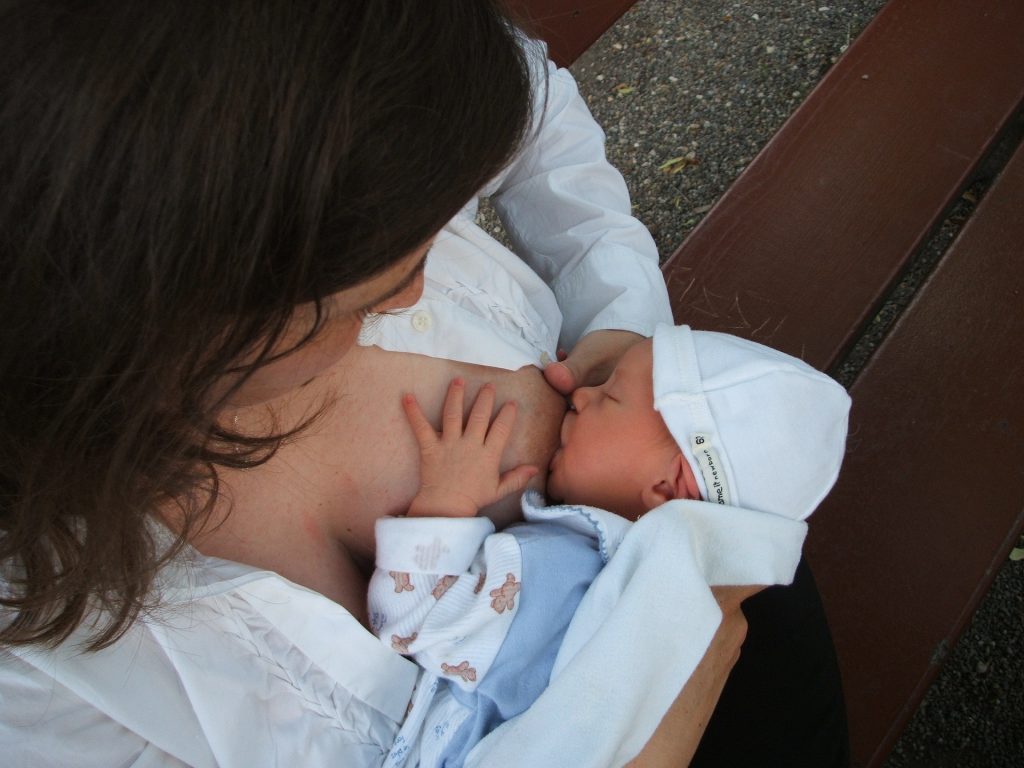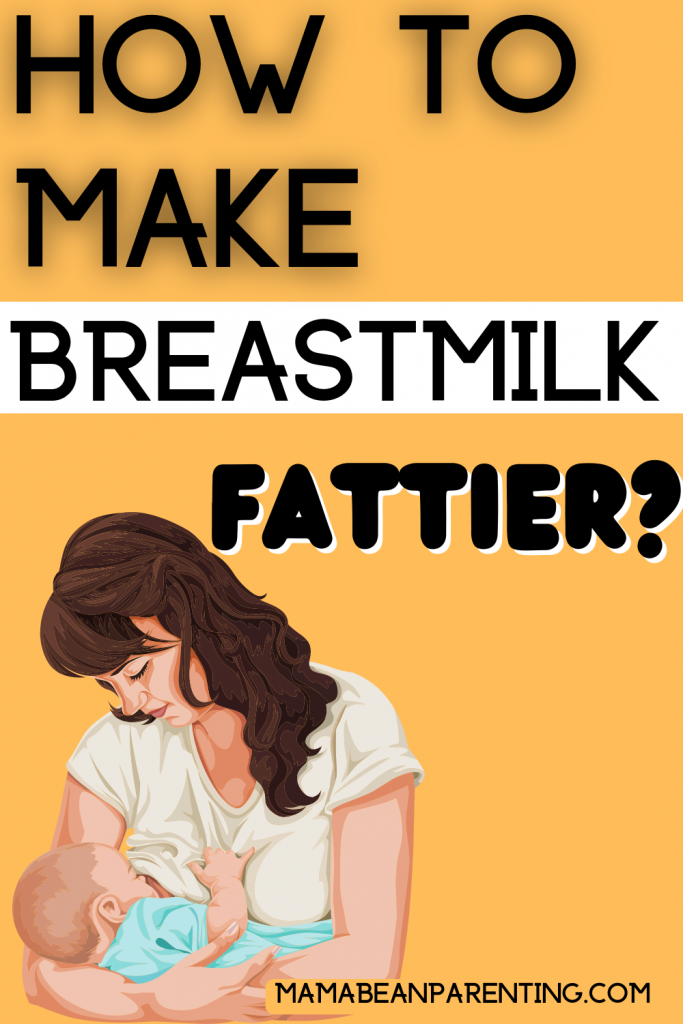Every mother out there would like to know how to make breastmilk fatter because she knows how essential proper nutrition and a healthy diet, in general, are for their baby.
Unfortunately, no mom can determine how much her baby has eaten while breastfeeding which is why they are unsure if the baby has received the right amount of nutrients during breastfeeding.
Not to mention the fact that a lot of them become even more stressed out after pumping due to the fact their milk supply becomes completely divided after sitting for a certain period of time.
Namely, the fatty hindmilk goes to the top, and the watery foremilk stays at the bottom of the container, and I believe that this sight doesn’t leave you too thrilled. On the contrary.
That’s why so many moms want to figure out how to make breastmilk fattier, but don’t worry, if you want to know how to increase fat in breast milk, I’ll immediately tell you that it’s something that can easily be accomplished.
Want to know how? Keep scrolling, and you’ll find out!
The Importance of Breast Milk Fat For Babies

It is widely known that babies grow fast, frequently tripling their baby weight, and growing around ten inches by their first birthday.
One of the main reasons why women want to know how to make breastmilk fattier is because they want to support this growth and help their baby stay healthy fully.
Just like adults, babies need lots of calories, which can be found precisely in breast milk. And the truth is, fats that are part of fatty breast milk are not only important for their growth but they also help develop their nervous system, brain, and eyes. Which means the higher fat, the better.
In case you didn’t know, 60 % of the brain and the area that surrounds the nerves contain fat.
Human Milk – Calorie and Fat Content
If you want to know how to increase fat in breast milk, then you first must get yourself familiar with the facts related to human milk.
Human milk, on average, has around 22 calories and 1.2 grams of fat per ounce. Out of all nutrients that can be found in human milk (including both vitamins and proteins), fats make up around three to five percent.
However, bear in mind that these numbers can be very volatile throughout the day, depending on the fullness of the breast, along with the baby’s age.
Factors that Impact Fat Content in Human Milk

Before I further dive into the “How to make breast milk fattier” topic, I would first like to discuss this. Several factors influence the fattiness of your milk supply, but the most common ones are the time of the day, frequency of feedings, how long the feeding lasts, and your diet.
The Time of Day
The time of day significantly alters the amount of fat in your milk supply. And of course, not every mother has the same amount of it.
Therefore, it would be advisable to pay attention to your daily breastfeeding session and jot down everything in a journal when it comes to breastfeeding.
What do you think about your breast milk?
When is it fatty enough? Is it in the morning, afternoon, or at night?
Make sure to check your notes as soon as every week is over. If you want to figure out how to make your breast milk fatty, then you first must figure out if any patterns in the fullness of the breasts happen.
If it does, then be sure to write down the time, so you can make the right changes.
If you notice that your breasts are fuller while your baby is sleeping, then ensure to pump and store the milk, so your baby is getting the best possible (fatty) milk while breastfeeding.
The Amount of Time that Has Gone by During the Feeding
The amount of fat you’ll find in breast milk depends on how full or empty your breasts are.
I’m about to say something that’s going to sound illogical but bear with me, please.
Namely, whether you believe it or not, an empty breast has higher fat, than the full one.
I know it sounds unbelievable, but it’s really true!
Consequently, if you want to know how to make breast milk fattier, then I suggest looking at the time that has passed since the beginning of breastfeeding.
The foremilk (the milk that’s available when your baby starts eating) is loaded with protein, water, and other nutrients. However, it is generally low-fat.
On the other hand, the hind milk (which can be seen at the end of the feeding session) is actually very fat, creamy, and more calorie-dense in comparison to the foremilk.
If you would like to know how to increase fat in breast milk because you’ve noticed that your baby isn’t getting enough of it, then you should opt for pumping. Pumping is going to be of huge help in these instances.
For instance, you can pump one-third of the milk in order to derive the foremilk and then start breastfeeding.
Pumping is going to enable your baby first to consume the hind milk. If your baby is still hungry after it, then just give your baby the foremilk.
The Frequency Between Feedings
There’s a common misconception in terms of breastfeeding and that is the more often you breastfeed your baby, the lesser amount of fat will be in the milk.
Well, that’s actually not the case. In fact, it’s actually much better to feed your baby more frequently but for a shorter period of time.
Of course, you can also feed your little angel on demand. As soon as you notice that your breasts are starting to fill, then it’s time for breastfeeding.
Your Diet
Before I further discuss this, I would first like to remind you that what you eat is not going to influence the amount of fat in the breastmilk.
However, it will impact the types of fat that your baby will receive through milk. That’s why you should pay attention to your diet.
If you’re scared that your child is not receiving high-quality nutrients through your breast milk, due to your diet don’t worry! I know something that can be of huge help.
Namely, on the market nowadays, you can stumble upon a variety of different lactation snacks and supplements that will positively impact your diet and will help you give your child all the necessary nutrients.
Foremilk VS Hindmilk

Now, I know you cannot wait to find out how to increase fat in breast milk, but before I proceed to that topic, I would just like to discuss foremilk and hindmilk briefly.
I did mention some facts above, but I would like to add some more useful info.
Namely, a lot of people believe that these are two completely different types of milk that were made by your breast.
However, that’s far from reality. In fact, foremilk is the milk that runs when your baby starts eating, while hindmilk is the milk that appears towards the end of the feeding.
In addition, some people believe that foremilk doesn’t contain milk fat at all, however, what you should pay attention to is the length of time between every feeding session. (which is something I discussed previously)
Basically, no one can determine the amount of fat that is in human milk solely by looking at it. Keep in mind that some women have bigger fat plugs or milk that’s creamier which does mean that their milk is fatty.
However, even if your milk looks a bit watery, it doesn’t necessarily mean that it doesn’t contain enough fat!
If you’re scared that your baby isn’t getting the right amount of fat, then what you need to do is talk to either a lactation consultant or pediatrician to see if your baby has potentially dropped a few ounces.
If that’s the case, then how to make breastmilk fattier so they can return to average weight.
I know that below I will tell you how to increase fat content in breastmilk, but it’s generally always a good idea to talk to health experts to see how they can help.
How Can You Tell If Your Milk Needs to Be Fattier?
Before I tell you how to make breast milk fattier, let’s first discuss some signs that could indicate that your milk doesn’t contain enough fat or simply isn’t nutritious enough for your little one.
What is the most obvious sign that something is “wrong” with your milk?
For starters, you will notice that your baby isn’t gaining any weight, even though you feed it frequently.
Another tell-tale sign that something isn’t right is the fact that your baby is losing some weight. Even though it’s completely normal if your child is losing some weight (that’s particularly normal during the first week), keep in mind that it’s supposed to regain it after breastmilk consumption.
If that isn’t the case, then as I stated above, please talk to your pediatrician.
Another sign that isn’t as common as the aforementioned ones is the fact that your newborn will most likely show signs of hypothermia.
That means that it is losing body heat fast because it doesn’t have enough fat in the body to regulate the temperature.
So how will you be able to tell if your baby is dealing with hypothermia?
Well, you will notice that your baby quickly feels cold. If you notice that then it definitely means that your milk doesn’t have enough fat and that you must figure out how to make breast milk fattier.
Top Ways to Make Breast Milk Fattier

Now, that I covered so many aspects of breastfeeding, it’s time to finally answer your question “How to make breast milk fattier?” because I know that you are dying to know.
Start With Healthy Fats
There’s a common misconception that if you want to make breastmilk fattier, you must eat lots of fat.
Well, not exactly. However, what you can most definitely do is start consuming more healthy fats because that’s something that will certainly positively affect the quality of your milk.
Not only are healthy fats beneficial for your little one, but for your body as well! After all, your baby cannot be healthy unless you are healthy too. Am I right?
So what should be eaten if you want to make breast milk fattier and at the same time, nourish both your body and baby’s body with the right things?
You need to include things like:
1. Walnuts
2. Cold-water fish, such as tuna, and salmon
3. Whole eggs
4. Chia seeds
5. Cheese
6. Avocado
7. Olive oil
8. Whole eggs
9. Nut butter
10. Vegetable oils
11. Nuts seeds
Now, does it mean that you should steer clear of anything that isn’t defined as healthy fats?
No, it doesn’t mean that. What I would advise you to do is to restrict unhealthy fats from processed foods and prioritize healthier types of fats, such as polyunsaturated fats and monounsaturated fats.
Both of these fats are not only beneficial for heart health, but for overall well-being.
I recently came across one study that has concluded that newborns who have consumed breast milk that was rich in one type of fat, known as omega-3 fat DHA have much better neurodevelopmental outcomes and vision.
Nurse As Frequently As Possible
Another great way to make breast milk fattier is precisely this one. As I mentioned numerous times, human milk consists of foremilk and hindmilk.
And both of them are equally important for the baby. Namely, you can perceive the foremilk as an appetizer that’s preparing your little foodie for the main course.
It’s something that’s going to increase its appetite so it can properly devour the hindmilk.
The hindmilk is actually the one that makes your little one feel fuller due to the fact that it’s packed with healthy fats that are necessary for the development of your kiddo.
After all, you want your baby to be healthy and strong, right?
However, at times, moms have to juggle multiple things at once, which results in a hectic feeding schedule, which isn’t a good thing because this causes hindmilk/foremilk imbalance.
Furthermore, if the feed isn’t long enough, or the breast simply is not fed frequently enough, then it does not get a chance to come out.
And something like this can lead to a variety of different problems.
Firstly, you’ll have to deal with clogged milk ducts, which could potentially disrupt milk flow and cause breast engorgement, and the second issue is that you’ll be having nursing pain.
Moreover, this inconvenience can create a problem for your little one too, as its stomach won’t feel like it’s full enough because precisely high-fat content of hindmilk is responsible for alleviating that feeling of hunger.
And if something like this occurs, this may lead to weight gain because your kiddo is constantly hungry.
Make Sure Your Breast Is Drained
A vast majority of new moms think that they must feed their babies from both breasts during each feeding.
Well, this doesn’t necessarily have to be the case.
When milk is produced, fat globules that are inside of it stick to each other, along with the walls of the alveoli, which are also known as milk ducts.
The milk slowly goes to the nipple as the breasts fill, bringing all that watery liquid forward, while leaving the creamier and fattier hindmilk behind.
That’s because it’s embedded in the walls of the ducts.
If you’re continuously switching from one breast to another, then it means that your baby is not going to receive enough fattier milk and precisely fattier milk helps increase the weight.
So what are you supposed to do then?
Well, for starters, make sure to massage your breast to see if there’s any milk left, and if there isn’t, yet you notice that your little one is still hungry, then you can switch to another breast.
Turn to Breast Compressions
If you notice that you aren’t making enough milk, or that your little one is having difficulties taking in all of it during each feeding, then you should definitely turn to breast compressions because they will stimulate your baby to eat more of the available milk.
How do these compressions work?
They work by pressing on the areola just enough so you get the feeling that there’s a taut band around it.
Another great thing about them is the fact that they will help you get some higher-fat milk off the walls of the duct.
The breast pump works in a similar way since it is applying pressure to help you extract as much milk as possible.
Now, if by any chance you notice that you do not produce enough milk, or that your kiddo isn’t capable of taking in all of the milk quickly, you should definitely turn to breast compressions, as well as breast massage to stimulate your baby to take in.
Although there’s no doubt that your hands are one of the best tools that you can employ for these purposes, it wouldn’t hurt to take any high-quality heated massager into account as well!

Breast Pump Can Be of Huge Help Too!
One of the best things about breastfeeding is the fact that you do not have to stress over washing baby bottles.
However, if you want your little one to receive all the milk fat it can get, then you can opt for a top-notch breast pump.
In case I didn’t mention before, a breast that’s relatively empty contains higher milk fat.
Therefore, if you pump before nursing, you’ll be able to empty your breast (and get all that foremilk out) so that your little angel doesn’t get full before it receives all that delicious milk fat.
Now, if you’ve never purchased a breast pump before, then I’ll tell you right now that on the market you can easily find an amazing breast pump that’s going to take this whole pumping experience up a notch.
According to the reviews I found online, the best ones, for the time being, are Willow potable wearable breast pump, Medela Harmony manual breast pump, and Spectra S1 breast pump.
Of course, these are all just suggestions to help you streamline pumping, however, you are the one who gets to decide which pump is the best for you and your kiddo.
But before you spend any dime on any breast pump, first be sure to contact your insurance company just to see if they will potentially cover expenses for the pump, so you can enjoy pumping without giving any money.
I Cannot Forget to Mention Protein
In terms of diet, I know that I told you that you’re supposed to incorporate more healthy fats into your dietary regime, but this rule applies to protein too.
If you want your breast milk to be healthy, then you simply must consume more protein.
It isn’t only beneficial for your child, but for you as well!
Namely, protein encourages milk production, and, at the same time, maintains a regular milk supply for all breastfeeding mothers.
Precisely this balances the amount of hindmilk and foremilk.
So what are the best options when it comes to this?
Below, I will enumerate the best sources of protein. They include:
1. Chicken breast
2. Different sorts of nuts
3. Fish
4. Dairy products
5. Eggs
6. Lean meats
7. A variety of different seeds
Generally speaking, nuts and seeds are some of the best options due to the fact that they are loaded with healthy fats.
It’s safe to say that all of the abovementioned foods contain everything you need to keep both yourself and your little one healthy.
That’s especially the case with flaxseeds.
Now, if by any chance you’re a vegetarian or vegan, yet you would like to ensure you have had your daily dose of protein, then you could always opt for protein shakes.
Most of these protein shakes contain enough protein to match your needs.
What About Supplements?
I would definitely give you the green light when it comes to this.
Namely, these supplements are perfect for all the moms out there whose milk supply is reducing, or who are constantly struggling to supply enough milk for their feeding session.
Precisely with these supplements, your breastmilk is going to become fattier!
These issues that I just mentioned are completely normal. Bear in mind that many women simply are not capable of pumping enough milk out on a regular basis.
Why is that happening?
Well, there are a plethora of factors that can negatively impact this, however, the most common one is stress.
If you’re interested in obtaining a high-quality supplement, then you should opt for sunflower lecithin.
It is widely recommended by various seasoned pediatricians and is especially intended for moms who are experiencing general breast pain, or who have issues with clogged milk ducts.
Furthermore, this supplement is going to bind hindmilk and foremilk together and will go through the ducts without creating any blockage.
In addition, it also provides some relief to mothers who have tried various methods of breastfeeding that weren’t unfortunately of huge help.
Speaking of supplements, before you acquire any, first be sure to consult your healthcare provider or lactation consultant just to see if it’s safe to take any supplements.
Even though a vast majority of women have never experienced any problems while taking them, it still wouldn’t hurt to consult some of these professionals.
Oh, and another thing! Please cast your eyes on the dosing instructions, since you can never be one hundred percent sure if your baby is potentially allergic to some of the ingredients.
In a nutshell, before you spend any money on these supplements, first do your homework because you do not want to jeopardize your baby’s health.
Conclusion

Baby nutrition is by far one of the biggest concerns of most parents. Hence it comes as no surprise why so many moms and dads wonder how to make breast milk fattier.
Fortunately, as you can see, it’s not as complex as you might think it is. There are so many effective, yet simple things you can do to make your breast milk fattier and turn your adorable angel into a chubby and healthy loaf of bread.

Well, hello there!
My name is Jennifer. Besides being an orthodontist, I am a mother to 3 playful boys. In this motherhood journey, I can say I will never know everything. That’s why I always strive to read a lot, and that’s why I started writing about all the smithereens I came across so that you can have everything in one place! Enjoy and stay positive; you’ve got this!



Feeding Aversion: All You Need to Know • Mama Bean Parenting
Monday 17th of April 2023
[…] you’re breastfeeding your baby and trying to make milk fattier, giving them milk from a bottle or introducing solid foods – observe their cues. Study their […]
4 Oz Breast Milk Equals How Much Formula? • Mama Bean Parenting
Friday 3rd of March 2023
[…] On the flip side, breast milk contains much more calories and fat than bottled formula, which means that your baby will feel fuller for a more extended period of time after being fed. There are also ways to make your milk fattier. […]
What Is the Best Protein Powder while Breastfeeding? • Mama Bean Parenting
Thursday 2nd of March 2023
[…] while breastfeeding, new moms need to supply their bodies with the proper nutrients to increase the production of breast milk and a healthy milk […]
Exclusively Pumping Schedule - How to Do It? • Mama Bean Parenting
Wednesday 1st of March 2023
[…] Even if you are not breastfeeding your baby in a traditional way, don’t forget that your milk is essential to your little one, and there are ways to make your milk fattier. […]
Can You Eat Lactation Cookies while Pregnant? • Mama Bean Parenting
Monday 27th of February 2023
[…] enough scientific evidence to prove this, breastfeeding mothers who have eaten them concluded that they boosted their milk supply which was previously […]